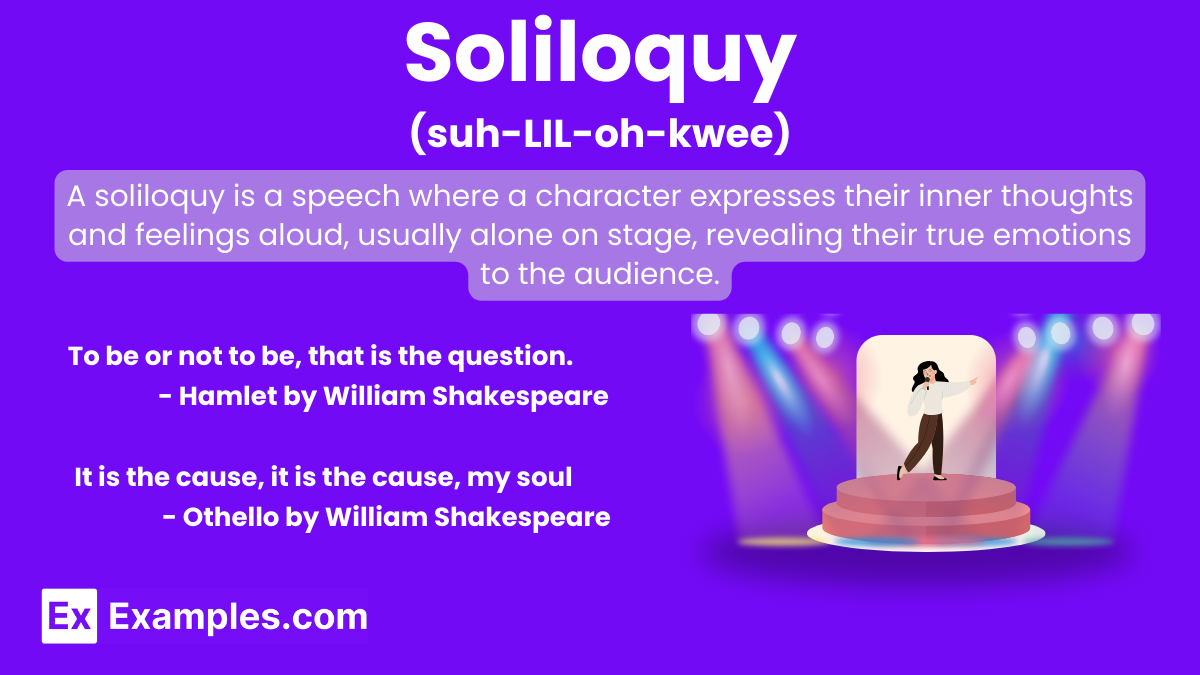Soliloquy
A soliloquy is a dramatic monologue where a character speaks their thoughts aloud, typically while alone on stage. This literary device allows the audience to gain insight into the character’s innermost feelings, motivations, and conflicts. Writers use soliloquies to reveal a character’s personal dilemmas and emotional struggles, offering a deeper understanding of their role in the story. Famous examples include Hamlet’s “To be or not to be” speech in Shakespeare’s play, showcasing the character’s profound contemplation about life and death. Soliloquies add depth and complexity to characters, making them more relatable and engaging for the audience.
What is Soliloquy?
Types of Soliloquy
Reflective Soliloquy
In a reflective soliloquy, the character contemplates their own thoughts and feelings, often pondering life’s big questions or their own actions. This type reveals the character’s inner conflicts and personal growth.
Narrative Soliloquy
A narrative soliloquy allows the character to recount past events or share background information. It helps the audience understand the character’s history and motivations without needing other characters to prompt the disclosure.
Decision-Making Soliloquy
In a decision-making soliloquy, the character weighs the pros and cons of a particular choice they must make. This type exposes the character’s reasoning process and the factors influencing their final decision.
Emotional Soliloquy
An emotional soliloquy highlights the character’s raw feelings, such as grief, joy, anger, or love. The character expresses these emotions openly, offering the audience a direct window into their emotional state.
Confessional Soliloquy
A confessional soliloquy involves the character admitting to actions, thoughts, or secrets they have kept hidden. This type reveals the character’s guilt, regrets, or true intentions, often leading to dramatic tension in the narrative.
Examples of Soliloquy
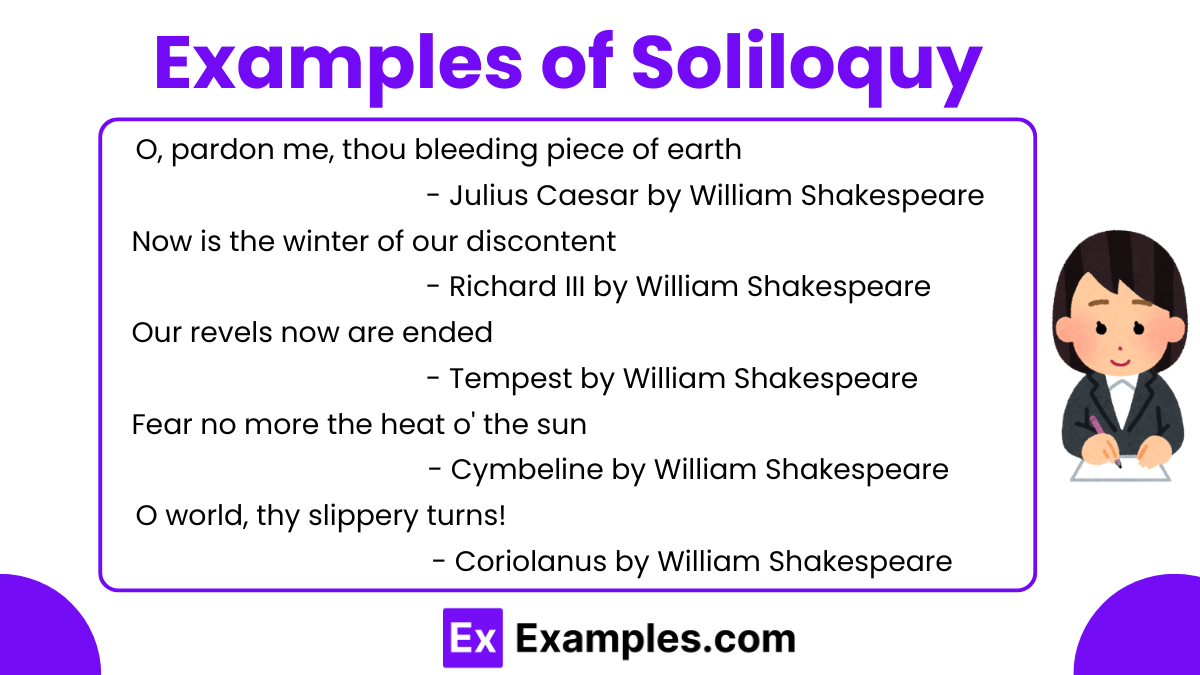
- Hamlet by William Shakespeare: “To be or not to be, that is the question.”
- Macbeth by William Shakespeare: “Is this a dagger which I see before me, the handle toward my hand?”
- Romeo and Juliet by William Shakespeare: “But, soft! what light through yonder window breaks?”
- Othello by William Shakespeare: “It is the cause, it is the cause, my soul.”
- Julius Caesar by William Shakespeare: “O, pardon me, thou bleeding piece of earth.”
- Richard III by William Shakespeare: “Now is the winter of our discontent.”
- The Tempest by William Shakespeare: “Our revels now are ended.”
- Hamlet by William Shakespeare: “O, what a rogue and peasant slave am I!”
- Macbeth by William Shakespeare: “Tomorrow, and tomorrow, and tomorrow.”
- As You Like It by William Shakespeare: “All the world’s a stage, and all the men and women merely players.”
- King Lear by William Shakespeare: “Blow, winds, and crack your cheeks! Rage! Blow!”
- Hamlet by William Shakespeare: “O, that this too, too solid flesh would melt.”
- The Merchant of Venice by William Shakespeare: “How sweet the moonlight sleeps upon this bank!”
- Measure for Measure by William Shakespeare: “To whom should I complain? Did I tell this, who would believe me?”
- Coriolanus by William Shakespeare: “O world, thy slippery turns!”
- Henry V by William Shakespeare: “Once more unto the breach, dear friends, once more.”
- Titus Andronicus by William Shakespeare: “If there were reason for these miseries.”
- Antony and Cleopatra by William Shakespeare: “I will be a bridegroom in my death, and run into’t as to a lover’s bed.”
- A Midsummer Night’s Dream by William Shakespeare: “How happy some o’er other some can be!”
- Twelfth Night by William Shakespeare: “I left no ring with her: what means this lady?”
- Cymbeline by William Shakespeare: “Fear no more the heat o’ the sun.”
Examples of Soliloquy for Students
- A Midsummer Night’s Dream by William Shakespeare: “I know a bank where the wild thyme blows.”
- Antony and Cleopatra by William Shakespeare: “O, then we bring forth weeds, when our quick minds lie still.”
- Hamlet by William Shakespeare: “O, that this too too solid flesh would melt.”
- Twelfth Night by William Shakespeare: “I left no ring with her: what means this lady?”
- The Merchant of Venice by William Shakespeare: “The quality of mercy is not strained.”
- Measure for Measure by William Shakespeare: “To whom should I complain? Did I tell this, who would believe me?”
- Cymbeline by William Shakespeare: “Fear no more the heat o’ the sun.”
- Titus Andronicus by William Shakespeare: “If there were reason for these miseries.”
- Coriolanus by William Shakespeare: “O world, thy slippery turns!”
- Henry IV, Part 1 by William Shakespeare: “I know you all, and will awhile uphold.”
Examples of Soliloquy in a Literature
- Hamlet by William Shakespeare: “To be or not to be, that is the question.”
- Macbeth by William Shakespeare: “Is this a dagger which I see before me, the handle toward my hand?”
- Romeo and Juliet by William Shakespeare: “But, soft! what light through yonder window breaks?”
- Julius Caesar by William Shakespeare: “O, pardon me, thou bleeding piece of earth.”
- Richard III by William Shakespeare: “Now is the winter of our discontent.”
- The Tempest by William Shakespeare: “Our revels now are ended.”
- King Lear by William Shakespeare: “Blow, winds, and crack your cheeks! Rage! Blow!”
- Othello by William Shakespeare: “It is the cause, it is the cause, my soul.”
- Henry V by William Shakespeare: “Once more unto the breach, dear friends, once more.”
- Doctor Faustus by Christopher Marlowe: “Was this the face that launched a thousand ships, And burnt the topless towers of Ilium?”
Examples of Soliloquy in Sentences
- Hamlet: “He did most of his thinking by soliloquy, often contemplating life and death in his famous ‘To be or not to be’ speech.”
- Macbeth: “Macbeth did most of his thinking by soliloquy, questioning his sanity with, ‘Is this a dagger which I see before me?'”
- Romeo and Juliet: “Juliet did most of her thinking by soliloquy, reflecting on the meaning of names with, ‘O Romeo, Romeo! wherefore art thou Romeo?'”
- Julius Caesar: “Brutus did most of his thinking by soliloquy, justifying the assassination of Caesar by saying, ‘It must be by his death.'”
- Richard III: “Richard did most of his thinking by soliloquy, revealing his ambitions with, ‘Now is the winter of our discontent.'”
- Othello: “Othello did most of his thinking by soliloquy, rationalizing his actions with, ‘It is the cause, it is the cause, my soul.'”
- The Tempest: “Prospero did most of his thinking by soliloquy, musing on life’s transient nature with, ‘Our revels now are ended.'”
- King Lear: “Lear did most of his thinking by soliloquy, raging against the storm with, ‘Blow, winds, and crack your cheeks! Rage! Blow!'”
- As You Like It: “Jaques did most of his thinking by soliloquy, philosophizing about life with, ‘All the world’s a stage.'”
- Henry V: “King Henry did most of his thinking by soliloquy, motivating his soldiers with, ‘Once more unto the breach, dear friends, once more.'”
Examples of Soliloquy in Movies
- The Lord of the Rings: The Two Towers: Gollum argues with himself over the One Ring.
- Pulp Fiction: Jules recites Ezekiel 25:17 before executing his enemies.
- Taxi Driver: Travis Bickle talks to himself in the mirror, saying, “You talkin’ to me?”
- The Shawshank Redemption: Andy Dufresne contemplates hope and freedom.
- Fight Club: The Narrator questions the meaning of his life and existence.
- Apocalypse Now: Captain Willard reflects on his mission and war.
- A Beautiful Mind: John Nash speaks about his struggles with schizophrenia.
- American Beauty: Lester Burnham narrates his life and the emptiness he feels.
- To Kill a Mockingbird: Atticus Finch delivers a heartfelt plea to the jury.
- Gladiator: Maximus remembers his family and vows revenge.
Examples of Soliloquy in Drama
- Death of a Salesman by Arthur Miller: Willy Loman speaks to himself about his dreams and failures.
- A Streetcar Named Desire by Tennessee Williams: Blanche DuBois talks to herself about her past and illusions.
- Long Day’s Journey Into Night by Eugene O’Neill: Mary Tyrone reflects on her lost youth and addiction.
- The Glass Menagerie by Tennessee Williams: Tom Wingfield talks about his feelings of entrapment and desire for escape.
- Oedipus Rex by Sophocles: Oedipus ponders his fate and the prophecy that haunts him.
- The Crucible by Arthur Miller: John Proctor contemplates his guilt and the hysteria in Salem.
- Macbeth by William Shakespeare: Lady Macbeth’s sleepwalking scene reveals her guilt and descent into madness.
- The Cherry Orchard by Anton Chekhov: Lyuba Ranevskaya reflects on her family’s past and the loss of their estate.
- Hedda Gabler by Henrik Ibsen: Hedda speaks to herself about her desires and frustrations.
- Hamlet by William Shakespeare: The famous “To be or not to be” soliloquy reveals Hamlet’s existential crisis.
1. Soliloquy Example
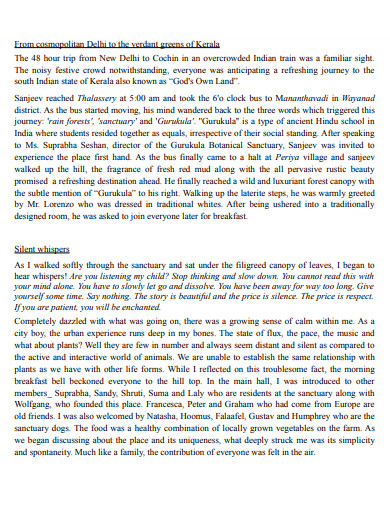
sanjeevshankar.com
2. Shakespeare Soliloquy Example
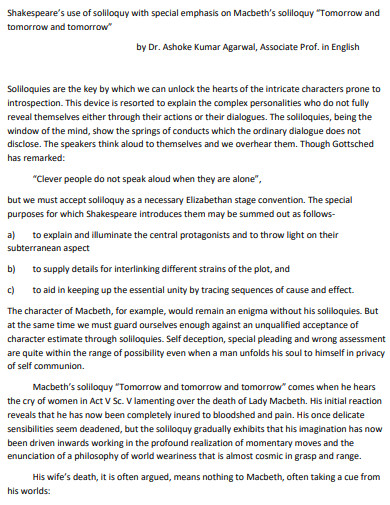
jkcprl.ac.in
3. Diversity of Soliloquy Example

totetu.org
4. Romeo Soliloquy Example
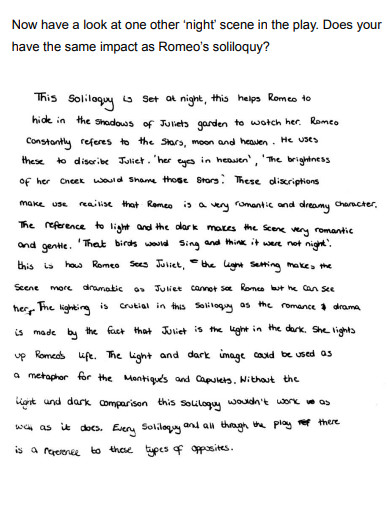
dera.ioe.ac.uk
5. Soliloquy Introduction Example
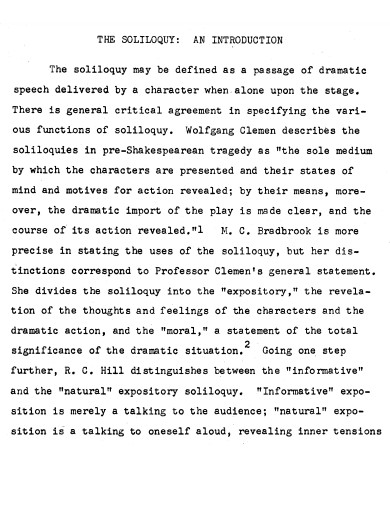
core.ac.uk
6. Macbeth Soliloquy Example
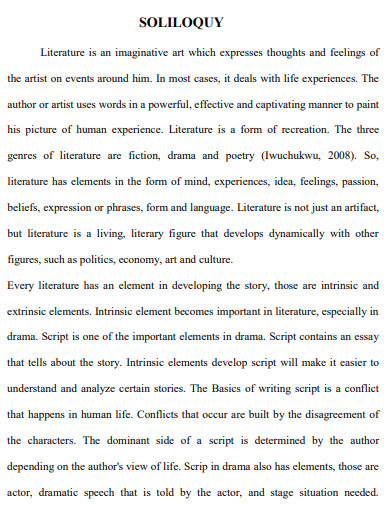
repository.umsu.ac.id
7. Love Soliloquy Example
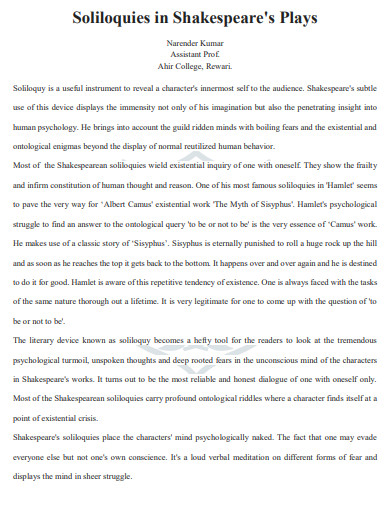
jetir.org
8. Soliloquy Example in DOC
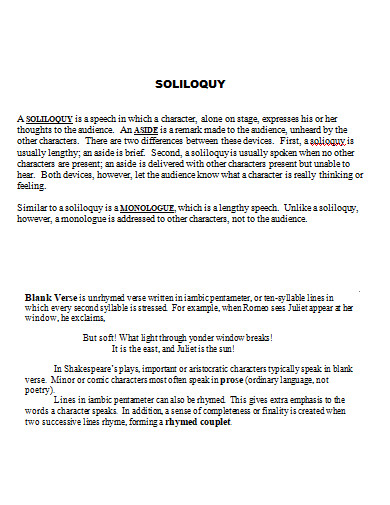
commackschools.org
Difference between Soliloquy vs Monologue
| Aspect | Soliloquy | Monologue |
|---|---|---|
| Definition | A speech where a character speaks their thoughts aloud, usually alone on stage. | A long speech by one character to other characters or the audience. |
| Audience | Intended to be heard by the audience only, not by other characters. | Intended to be heard by other characters and/or the audience. |
| Purpose | To reveal the character’s inner thoughts, feelings, and motivations. | To communicate information, tell a story, or express thoughts and emotions. |
| Context | Typically delivered when the character is alone or believes they are alone. | Delivered in the presence of other characters or directly to the audience. |
| Interaction | No direct interaction with other characters during the speech. | Can involve interaction or reaction from other characters. |
| Examples | Hamlet’s “To be or not to be” in Hamlet. | Mark Antony’s “Friends, Romans, countrymen” in Julius Caesar. |
| Length | Often shorter and more focused on introspection. | Can be longer and cover a broader range of topics. |
| Emotional Tone | Often reflective, contemplative, or confessional. | Can vary widely from persuasive to narrative to reflective. |
| Setting | Occurs in a private or seemingly private setting. | Occurs in public or social settings. |
| Usage in Drama | Used to develop character depth and reveal personal dilemmas. | Used to advance the plot, provide exposition, or deliver important messages. |
Function of Soliloquy
Revealing Inner Thoughts
A soliloquy allows a character to express their innermost thoughts directly to the audience. This provides insight into the character’s mind, revealing their true feelings, intentions, and dilemmas that might not be apparent through dialogue with other characters.
Developing Character Depth
Soliloquies help to develop the depth of a character by showing their personal struggles, conflicts, and motivations. This allows the audience to understand the complexities of the character, making them more relatable and multidimensional.
Advancing the Plot
Through a soliloquy, a character can outline their plans, decisions, or actions, which helps to advance the plot. This can create suspense and anticipation as the audience becomes privy to information that other characters in the play may not know.
Creating Dramatic Irony
A soliloquy can create dramatic irony by giving the audience knowledge that other characters in the play do not have. This can heighten the tension and engagement, as the audience watches events unfold with a deeper understanding of the character’s intentions and possible outcomes.
Expressing Emotions
Soliloquies provide a platform for characters to openly express their emotions, such as love, anger, grief, or joy. This emotional expression can help the audience connect with the character on a deeper level, evoking empathy and emotional responses.
Highlighting Themes
By delving into the character’s thoughts and reflections, soliloquies often highlight central themes of the play. These themes might include existential questions, moral dilemmas, the nature of power, or the complexity of human emotions.
Providing Exposition
Soliloquies can offer background information or context that is crucial for understanding the story. This exposition can fill in gaps, explain past events, or clarify relationships between characters, enhancing the audience’s comprehension of the plot.
Foreshadowing
A soliloquy can foreshadow future events in the play. By revealing a character’s plans or predictions, the soliloquy sets the stage for upcoming actions and conflicts, creating a sense of anticipation and expectation.
Enhancing the Audience’s Engagement
By breaking the fourth wall and speaking directly to the audience, soliloquies can create a sense of intimacy and engagement. This direct communication can draw the audience deeper into the character’s world and the overall narrative.
Reflecting on Past Events
Characters may use soliloquies to reflect on past events, offering their perspective and interpretation. This reflection can provide insight into the character’s development and how past experiences have shaped their current actions and mindset.
Purpose of a Soliloquy
- Revealing Inner Thoughts: Allows characters to share their inner thoughts and feelings directly with the audience.
- Developing Character Depth: Provides insight into the character’s true nature, conflicts, and growth.
- Advancing the Plot: Moves the plot forward by revealing a character’s plans, decisions, or realizations.
- Creating Dramatic Irony: Gives the audience information that other characters do not have, enhancing tension and engagement.
- Expressing Emotions: Helps characters express their emotions openly, allowing the audience to connect with them.
- Highlighting Themes: Touches on central themes of the play, contributing to the overall message and depth of the narrative.
- Providing Exposition: Offers crucial background information or context, filling in gaps in the story.
How to Write a Soliloquy
A good soliloquy allows the audience to relate with the character and will improve the target audience’s impression or thoughts on the overall text. If you need good soliloquy examples, samples, and formats, you may use any of the links in the sections above.
Step 1: Select the Context of the Scene
The context of the scene will determine the overall tone, form, and length of the scene the person will act or speak aloud. Before thinking about writing the soliloquy, you must choose and select the context of the scene.
Step 2: Determine the Literary Devices You Will Use
One can opt to use literary devices in their soliloquy to improve and have an augmented message they will relay to their audience. You must determine which literary devices you will use on your soliloquy before thinking about writing the scene.
Step 3: Write the Soliloquy
When you have finished choosing the context and literary devices you will use in the soliloquy, you must now write the content of the scene. You can opt to use various outlines or outline formats that can help you properly and strategically pace out the soliloquy.
Step 4: Read Out Loud the Soliloquy
After you have finished writing your soliloquy, you must try either reading the scene out loud or having someone else proofread the scene. This will allow you to hear the scene through your ears and help figure out if there are any necessary changes or edits to the scene.
How to Deliver a Soliloquy
- Understand the Text: Analyze the character’s emotions, motivations, and context within the play.
- Embrace the Character: Fully embody the character, understanding their personality, background, and situation.
- Connect with the Audience: Engage the audience through eye contact and facial expressions.
- Use Appropriate Tone and Pace: Match your tone and pace to the content of the soliloquy.
- Utilize Body Language: Complement the words and emotions with gestures, posture, and movement.
- Practice Emotional Expression: Convey subtle nuances in feelings, from sorrow to joy, for a powerful performance.
- Manage Your Breath: Practice breathing techniques for a clear and strong delivery.
- Rehearse Thoroughly: Gain confidence and fluidity by practicing the soliloquy multiple times.
- Stay in Character: Remain fully immersed in the character during the performance.
- Seek Feedback: Refine your delivery based on feedback from a director, coach, or trusted peers.
What Describes a Soliloquy?
A soliloquy is a speech where a character speaks their inner thoughts aloud, typically alone on stage, revealing their true feelings to the audience.
What Is the Main Purpose of a Soliloquy?
The main purpose of a soliloquy is to provide insight into a character’s inner thoughts, feelings, and motivations, enhancing the audience’s understanding.
What Happens in a Soliloquy?
In a soliloquy, a character speaks their thoughts and emotions aloud, often contemplating significant decisions or reflecting on their situation, without interacting with other characters.
What Makes a Good Soliloquy?
A good soliloquy is introspective, emotionally compelling, and reveals the character’s deepest thoughts and conflicts, connecting with the audience on a personal level.
What Is the Greatest Soliloquy of All Time?
The greatest soliloquy is often considered Hamlet’s “To be or not to be” from Shakespeare’s Hamlet, reflecting on life, death, and existential questions.
What Are the Key Features of a Soliloquy?
Key features of a soliloquy include introspection, emotional depth, personal reflection, and the absence of other characters, providing direct insight into the speaker’s mind.
What Makes a Soliloquy So Powerful in a Play?
A soliloquy is powerful because it allows the audience to access the character’s innermost thoughts and emotions, creating a deeper connection and understanding.
How to Perform a Soliloquy?
To perform a soliloquy, understand the character’s emotions and motivations, use appropriate tone and body language, maintain strong eye contact, and practice thoroughly for a compelling delivery.
Is Romeo and Juliet a Soliloquy?
No, Romeo and Juliet is a play by William Shakespeare. It contains several soliloquies, such as Juliet’s “O Romeo, Romeo! wherefore art thou Romeo?”
Is Talking to Yourself a Soliloquy?
No, talking to yourself is not a soliloquy. A soliloquy is a structured speech in a play where a character reveals their inner thoughts aloud to the audience.



